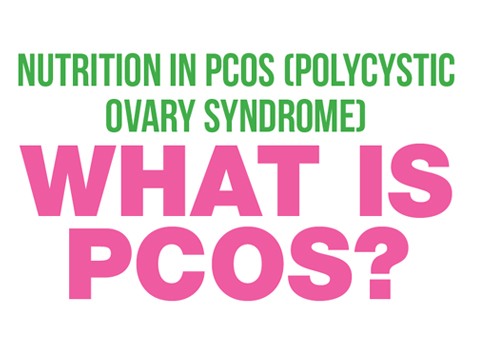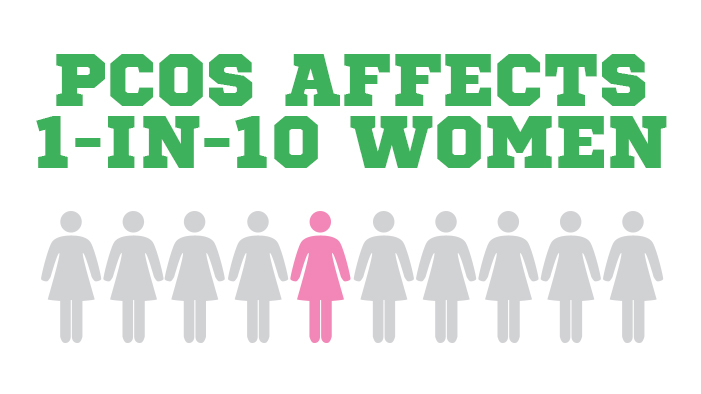Home Diet & Nutrition what is pcos ?
What Is PCOS ?

By Nutan Khimasiya
Nutrition in PCOS (Polycystic Ovary Syndrome)
Polycystic Ovary Syndron (PCOS) is a genetic. Hormonal, metabolic and reproductive disorder that affects women.

It is leading cause of female infertility. PCOS can also lead to other serious conditions including severe anxiety and depression, obesity, endometrial cancer, type 2 diabetes and cardiovascular disease.
10% - Women of childbearing age estimated to have Polycystic Ovary Syndrone
50% - Women with PCOS going undiagnosed
50%- Women with PCOS who will develop type 2 diabetes or prediabetes before age 40
4.3 Billion - Estimate annual cost to the American healthcare system to diagnose and treat women with PCOS
3x - 3X The increased risk of women with PCOS developing endometrial cancer
COMMON SINGHS ANS SYMPTOMS
IRREGULAR PERIODS
EXCESS FACIAL AND BODY HAIR
SEVERE ACNE
SMALL CYSTS IN OVARIES INSULIN RESISTANCE
ANXIETY AND DEPRESSION
INFERRILITY
WEIHT GAIN
MALE PATTERN HAIR LOSS
The focus of nutritional therapy for treating PCOS is targeted on controlling blood sugar and reducing excess body weight, the known complications usually found in this syndrome. Insulin resistance in PCOS is the area of most concern as excess insulin increases the levels of testosterone, causing hormonal imbalance leading to symptoms such as acne, excess facial hair (hirsutism) and irregular periods. Increased physical activity and healthy food choices can improve the symptoms of PCOS.
Following Nutritional recommendations have prove to be beneficial for patients and clients with PCOS:
1. Add a physical activity in daily routine. Being physically active improves your body’s response to insulin. Because working muscles directly use blood glucose for energy, there is less production of insulin.
2. A weight loss of even 10% of body weight has shown to increase insulin sensitivity and improved blood sugar control.
3. Targeting a weight loss of 0.5 kg/week is healthy, safe and realistic.
4. Your total caloric consumption should not be less than 1400 kcal/day;
• With 15 to 20 % from lean proteins such as egg whites, lean meat (skinless chicken breast, center cut lamb without fat) fish,, 2 to 3 servings/day of (skim and 1% milk, low-fat yogurts, paneer, low-fat or lite cheese), soy milk, tofu, hummus, pulses (soybeans, dried beans, lentils and peas).
• Not more than 25 to 30% from fat especially monounsaturated fats (olive, peanut and sesame oil, seeds and pastes; nuts such as almonds, cashews, peanuts and pecans; and peanut butter).
• Emphasize on gradually increasing high fiber, low glycemic index (GI) foods like fruits (raw, non-fleshy), vegetables and whole grains like oats, barley, legumes (peas, beans and lentils), corn, bran, seeds and nuts.
5. Include dietary sources of Omega 3 fatty acids found in cold water fatty fish, fish oil, flax seed oil, walnut oil, soybean and mustard oil.
6. Include protein with most meals and snacks as it lowers GI of the food consumed. Hence, slow rise in blood glucose and steady release of insulin and its better sensitivity.
7. Phyto-nutrients in low fat dairy foods, cinnamon, nuts (especially walnuts) orange and leafy green vegetables (such as spinach), carrots, yams and sweet potatoes are said to improve insulin resistance.
8. Certain functional foods that may improve insulin sensitivity can be included in diet namely cinnamon 4gm, fenugreek soaked 1 tbsp, herbal teas (spearmint tea) for their anti-inflammatory, lipid and testosterone lowering properties respectively.
9. Vitamin D3 (cholecalciferol) supplementation can be beneficial as its deficiency is associated with insulin resistance and decreased pancreatic beta cell function.
10. Because metformin affects B12 absorption, deficiency is scene in those on long term doses for diabetes. Hence, a multi-vitamin supplement with B12 is necessary, especially for vegetarians.
11. Avoid saturated fats (butter, ghee and animal fats) and food containing trans-fats (packaged and processed fast foods, deep fried restaurant foods and products not labeled as trans free).
12. When eating out control portion size, especially restaurants and fast food joints have portions enough for 2 people. Always order half serving or parcel half serving if possible or when accompanying with someone order for 1 by 2 option.
13. Follow earlier guidelines for protein when ordering non-veg food in restaurants; like order for lean meat or fish and steamed items.
14. Avoid any hidden fats when ordering salads and sandwiches, order without dressing, mayo, butter and sauces. They can be served along with the dish to control the amounts.
Follwing these and making gradual changes in your diet will help you addsin the issue of PCOS successfully.
